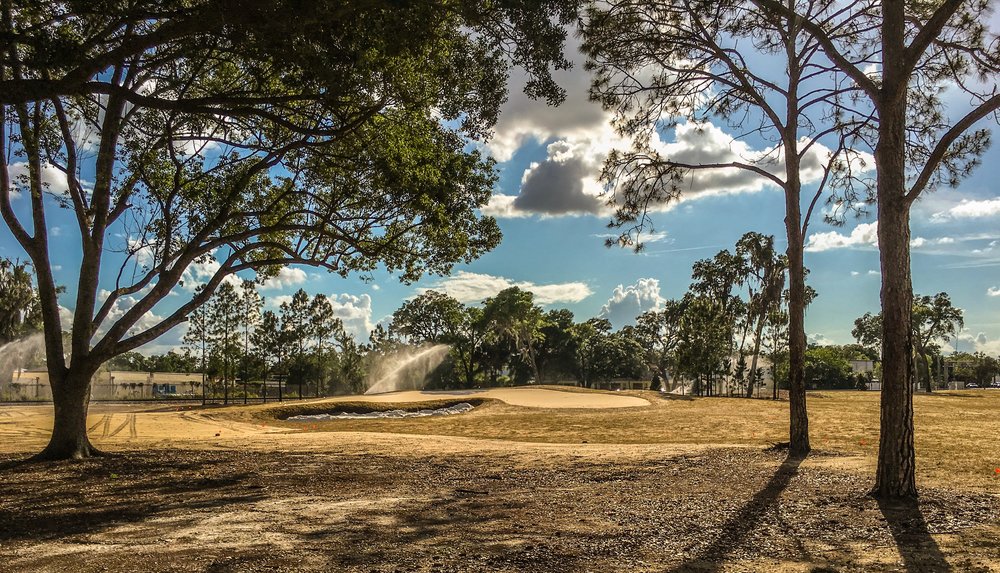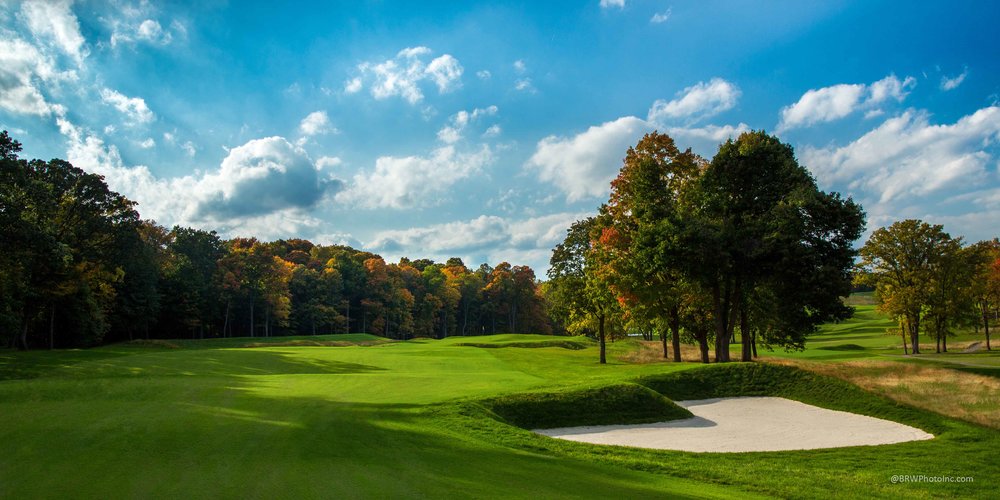Who do you feel is the most under-appreciated architect, living or dead? And why? – Andrew P
For me, the most under-appreciated golf course architect was Ralph Plummer. Most people have probably never heard of him. He was from Fort Worth, Texas, was born in 1900, and died in the early 1980’s. The majority of the 100 golf courses he worked on were in Texas, so I guess you could call him a regional golf course architect. His career started with him working as a construction foreman for John Bredemus and one of his first jobs was building Colonial Country Club in Fort Worth. From there, Mr. Plummer went on to design two other courses that hosted major championships – Champions Golf Club in Houston where Orville Moody won the 1969 US Open (and where the 1967 Ryder Cup and 1993 US Amateur were played), and Dallas Athletic Club where Jack Nicklaus won the 1963 PGA Championship.
Other prominent courses designed by Mr. Plummer include Preston Trail in Dallas, Shady Oaks in Fort Worth (with Robert Trent Jones Sr.), Tryall Golf & Beach Club in Jamaica, Squaw Creek Golf Course in Willow Park, Texas, and Ridgewood Country Club in Waco. Mr. Plummer was great at routing golf courses and he had a knack for getting the most out of each project as most were done on very limited budgets. Having grown up and lived in Texas for most of my life, I have been fortunate to play many of his courses, and now I have been lucky enough to work on a few of them as well. One thing that I have noticed is how well the golf courses are routed and how much the Texas winds influenced his designs.
While Ralph Plummer will never be mentioned in the same sentence as the Alister MacKenzies of the world, his work is worth studying for what he did with small budgets. – Trey Kemp, Colligan Golf
What was the first course you saw or played that got you interested in architecture? – Bob F
I spent a lot of time playing golf and hanging out on the golf course with my Grandpa when I was as a kid, but always on the local muni. I never understood early in my life that golf course architecture even existed. Fast forward to my early-twenties when I was spending a lot of time in Latin America, especially Mexico. One of the places I stayed in was Cabo San Lucas. I was helping build Querencia Golf Club for Tom Fazio, and I got a chance to play Cabo del Sol. I was exposed to Nicklaus and Fazio’s work at the same time, and I had a real opportunity to compare and contrast the two. I could really see what an amazing site was, and started imagining the things I loved on these two courses, and the things I would have done differently. Both courses are still regarded as two of the best in Latin America, and I was lucky to be exposed to both of them early in my career. – Casey Krahenbuhl, DMK Golf Design (Listen to our podcast with Casey Krahenbuhl here)
Favorite and least favorite aspects of the design process? – Russell K.
I have two favourite aspects of golf design. The first is site analysis (part of the routing process), and the second is the construction process. There is nothing more enjoyable than walking a piece of raw land while visualizing and sketching potential green sites, bunkers, and fairway corridors. Taking your time to accurately inspect the land is invaluable as it helps you get a good feel for the topography. Many interesting natural features do not show up on a topo map, which is why I like to walk. When you feel comfortable with the land, you can really start to chip away at routing a seamless collection of all-world golf holes.
The construction process is really fun, mainly because you actually get to carry out your thoughts and ideas. I love sculpting greens, digging bunkers and rumpling up fairways. From heavy earthmoving to putting the finishing touches on a green, there is so much variety in your work flow. Having the ability to implement your own designs using a bulldozer or excavator is so satisfying as you can make sure the fine details are being brought to life.
Least favourite aspect of golf design – sitting in an office! Although that can be fun with good tunes and good company. – Trevor Dormer, Integrative Design Co.
What recommendations do you have for someone who wants to start a career in golf course architecture? How do you get started? – Axel O
There are multiple paths into a golf course design career. Some people go to school for a related degree (e.g. landscape architecture, turf management, agronomy), followed by real-world experience in a golf industry job. Some might have a completely unrelated degree, but their love for golf and course aesthetics drive them in to the field. Other people don’t have a college degree, but they capitalize on job opportunities/experiences and work their way into it. Regardless of the path, most design work comes after time, hard-work, and sacrifices that pay off over the long run – or at least that is the hope.
My path was atypical. After two years of simultaneously working a concrete job and going to school for a degree in landscape architecture, I jumped on an opportunity to work for a large golf course development company. The job took me to Agar, SD, where I did grunt work during construction of Sutton Bay Golf Course. One project led to the next, and six years later, I was fortunate enough to be working as a shaper for Coore & Crenshaw. Fifteen years after starting in the industry, I completed my first design project.For those interested in golf course architecture/design work, I recommend gaining as much real-world experience as possible in both golf course construction and design arenas. My time at the golf course development company exposed me to a wide variety of design elements and philosophies (not to mention personalities). But most importantly, I learned the factors (e.g. site-conditions, irrigation, soil management, drainage, grow-in periods, etc.) critical to a design concept’s viability once it is built. These might not be the most glamorous things for designers to know and understand, but they are essential to quality craftsmanship that influences any course’s playability, maintenance, and sustainability.
Also, be open to the people and opportunities that come into your life as you get started. Often, entry-level jobs in this industry are temporary, and not what you envisioned for yourself as a professional. Remember that while the position might be temporary, the impressions that you make (for better or for worse) endure. Use every position as an opportunity to grow as a person, and to strengthen the foundation for a strong professional future. – Keith Rhebb, Rhebb Golf Design (Listen to our podcast with Keith Rhebb here)

Hole 6 at Keith's Winter Park GC in Orlando, FL
How would you describe your design philosophy? – Steve L.
My philosophy is best described as natural, strategic, and sustainable. I like to use the phrase: “Golf Architecture is a blend of art and science. Classic, timeless design is the art I practice, and the science is where a course’s longevity lies.” My golf courses take on the characteristics of a given site, and the design style is driven by what kind of golf course I’m looking to create. A large part of my design process is focused on the putting greens and recovery from a missed shot, while not beating a player up too much off the tee. Each course of mine is driven to be a strong reflection of the site and my client’s goals, with priority placed on how I like to see the game of golf translated on a playing field – on the ground, with your friends, thinking your way through each shot. – Andy Staples, Staples Golf Design (Listen to our podcast with Andy Staples here)

The third hole at Meadowbrook C.C., an Andy Staples project
Why don’t any of today’s architects use the straight lines on the front of the greens like McDonald and Raynor did? – Michael W
Of their work, I’ve only seen NGLA and Chicago, so I’m hardly an expert on it. Those two courses are among my favourites, and the straight lines in no way feel odd or out of place. MacKenzie and others followed the path of there being “no straight lines in nature”, and made greens with rounded-off fronts and edges – and in Australia, MacKenzie and Alex Russell cut bunkers into the edges of greens to create quite irregular shapes. It’s not like one is better than the other – it’s diversity, and that’s a good thing. – Michael Clayton, OCCM (Listen to our podcast with Michael Clayton here)


 by
by 
